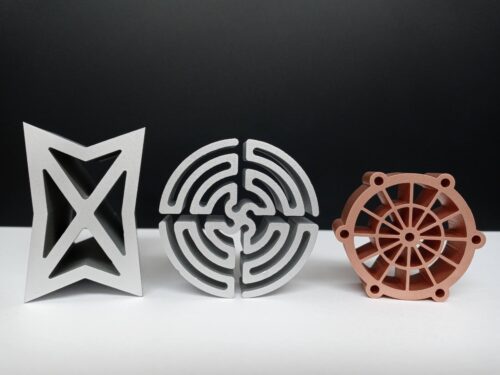When you need parts fast, waterjet cutting can deliver. Using this quick and easy manufacturing method, Wagner Machine frequently turns around waterjet parts in just one day.
To keep lead times short and costs down, we advise customers to follow five best practices when submitting an RFQ for waterjet parts.
1. Include a 2D CAD file AND a 2D PDF file
Programming waterjet parts is usually quick, and a 2D CAD file works best. Solid model files are great for most other machined parts, but for the waterjet process, we will need to convert the solid to a 2D vector geometry format which adds an extra step.
Sending a 2D CAD file in DXF or DWG format with your RFQ allows our waterjet department to start calculating cycle times and material utilization immediately so we can turn around a quick quote. It is best if the file is scaled 1:1, but if it isn’t, the scale should be listed clearly in the file or in the notes of the RFQ.
We also ask customers to provide a part print in PDF format. We use the PDF to double check that the CAD file is scaled correctly and to make sure we can hold the required tolerances with the waterjet process.
2. Clarify material selection
Believe it or not, we receive many quote requests for waterjet cutting services that don’t specify the desired material. It’s one of those things that’s so obvious many customers easily overlook it! If your print doesn’t specify the material thickness or type, please mention it in the RFQ notes.
If you forget, we’re happy to reach out and have a conversation about materials, but providing all the information will save your time and ours.
Consider choosing a material we stock in-house—6061 aluminum, 5052 aluminum, 304 stainless steel, cold finish steel sheet, and A36 hot roll steel plate—for the quickest turnaround. In many cases, we can start cutting your part the same day or the next when using one of our standard materials. We can also get most non-stocked materials within 1-2 days.

3. Call out critical features and tolerances
The PDF print should ideally be minimally dimensioned to include overall part dimensions (including material thickness in inches or millimeters instead of gauge thickness), features with tight tolerances, and hole specs, such as tap or counterbore information. Don’t overdo it.
Regarding tolerances, +/-.010” is easy and +/-.005” is not too bad on a waterjet. We can hold even tighter tolerances by adding a secondary machining op or using test cuts to dial in the waterjet process. If additional processes or test cuts are required, we will make a recommendation based on tolerance, part size, feature size, material type, and material thickness.
4. Draw features in the middle of the tolerance range
Whether you have a bilateral tolerance which has an even +/- tolerance, or a unilateral tolerance where + and – can be different, it’s important to draw the feature in the middle of the tolerance range.
For example, if a hole needs to be .500” or bigger to ensure a slip fit, an engineer will often specify a unilateral tolerance of .500” +.010”/-.000”. This is a great way to express design intent, however, if the hole is drawn at one extreme end of the tolerance range, .500” for example, it will be programmed and cut at size and there is a high risk of the feature measuring slightly out of tolerance. If at all possible, draw or model all features on solid models and 2D CAD files in the middle of your tolerance range regardless of how you want to display your tolerance.
We have no problem adjusting CAD files if we catch this, but if you can save us this step, we will save you time and cost on the quoting and machining process.
5. Provide an unfolded view of formed parts
If your parts require forming or bending, include a flat blank view on the 2D CAD file.
If you can’t provide one, we’ll request a solid model file, which allows our engineering department to unfold the part in our CAD software. This workaround is absolutely possible but—you guessed it—adds time to the project.
Good News!
We know that speed is a priority for many of our customers, and following these guidelines will allow us to provide a fast quote and get to work right away. If you can’t follow all five guidelines, do the best you can. The good news is that we can work with almost anything including a broken sample part, napkin sketch, or picture if that’s all you have. Request a quote for your waterjet parts, and let’s get started today!
